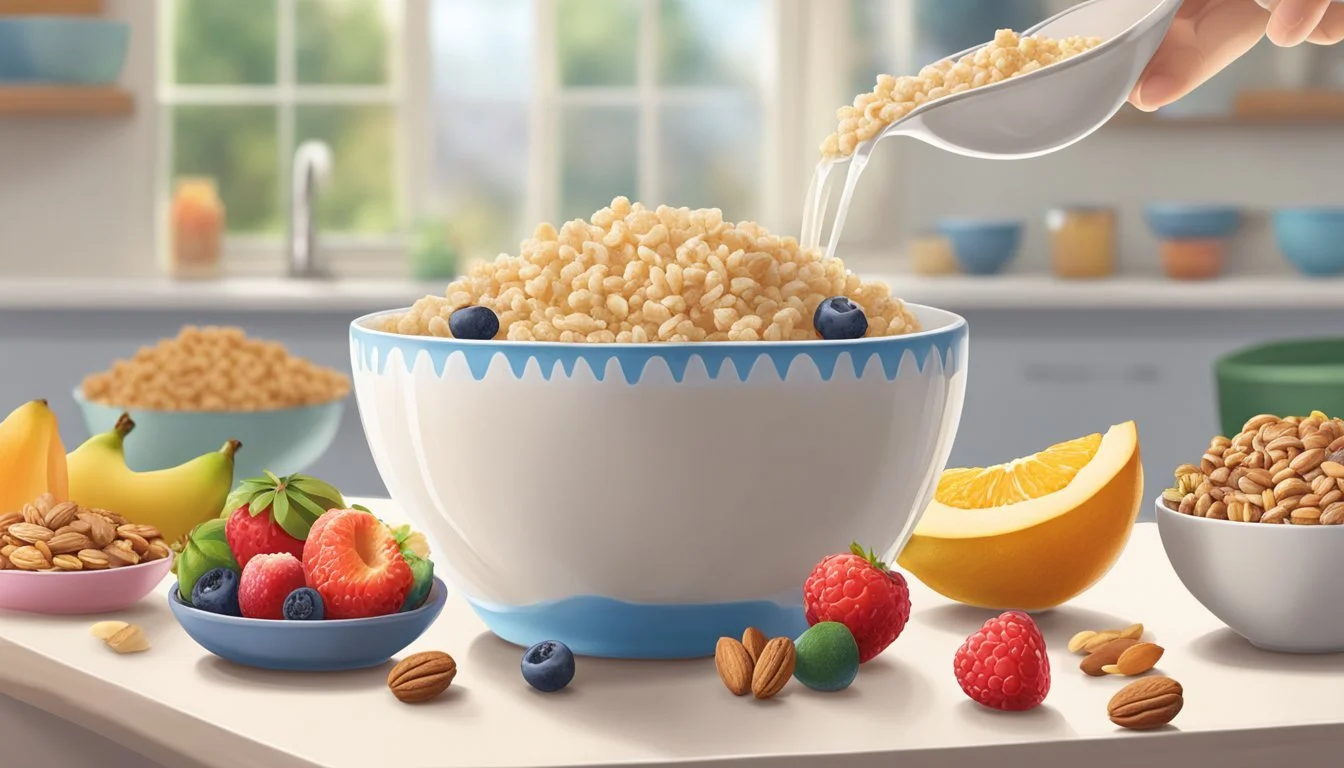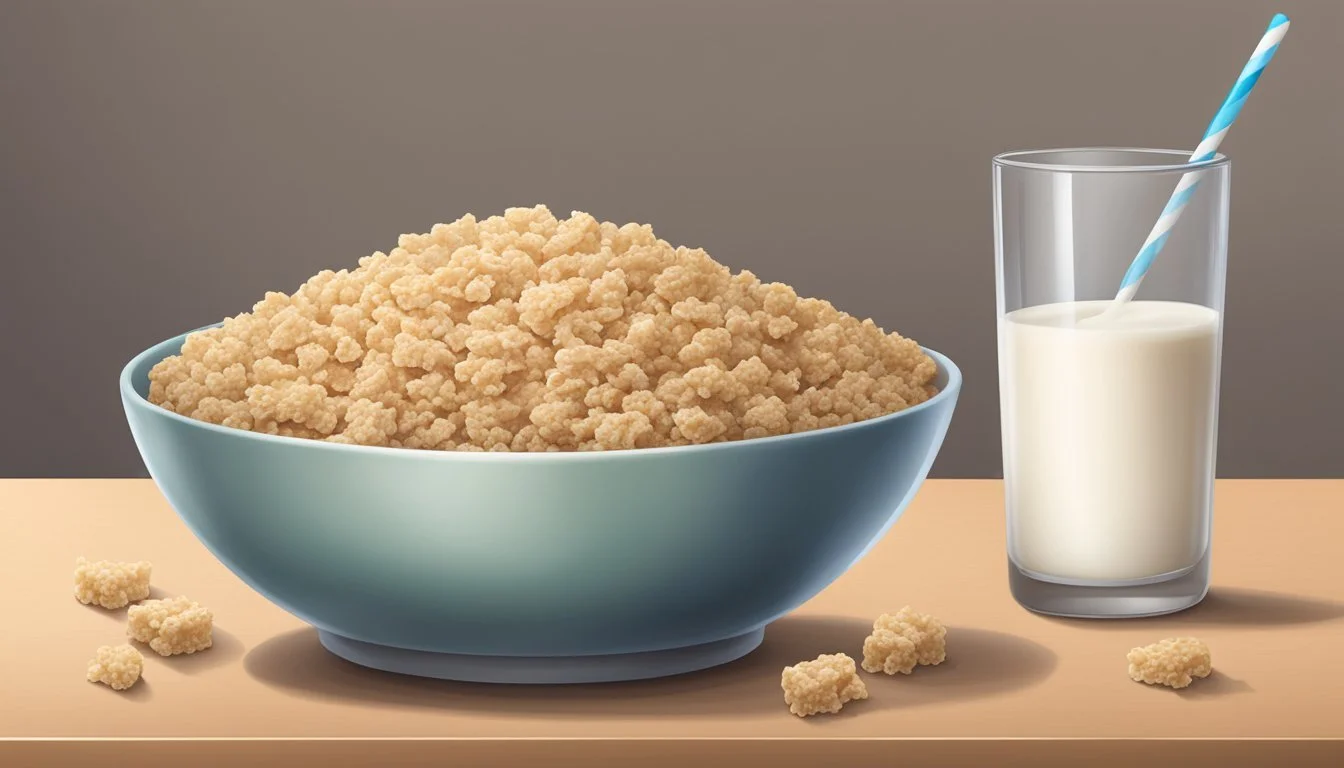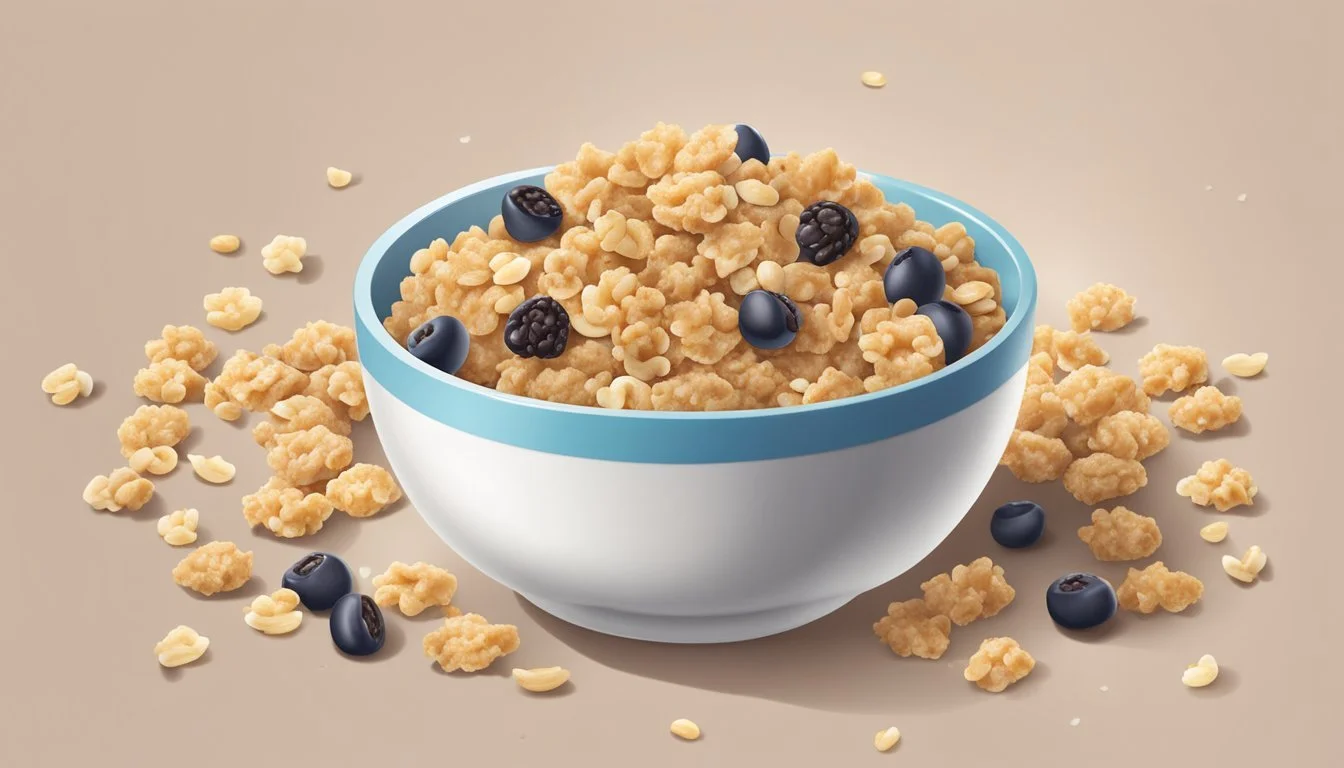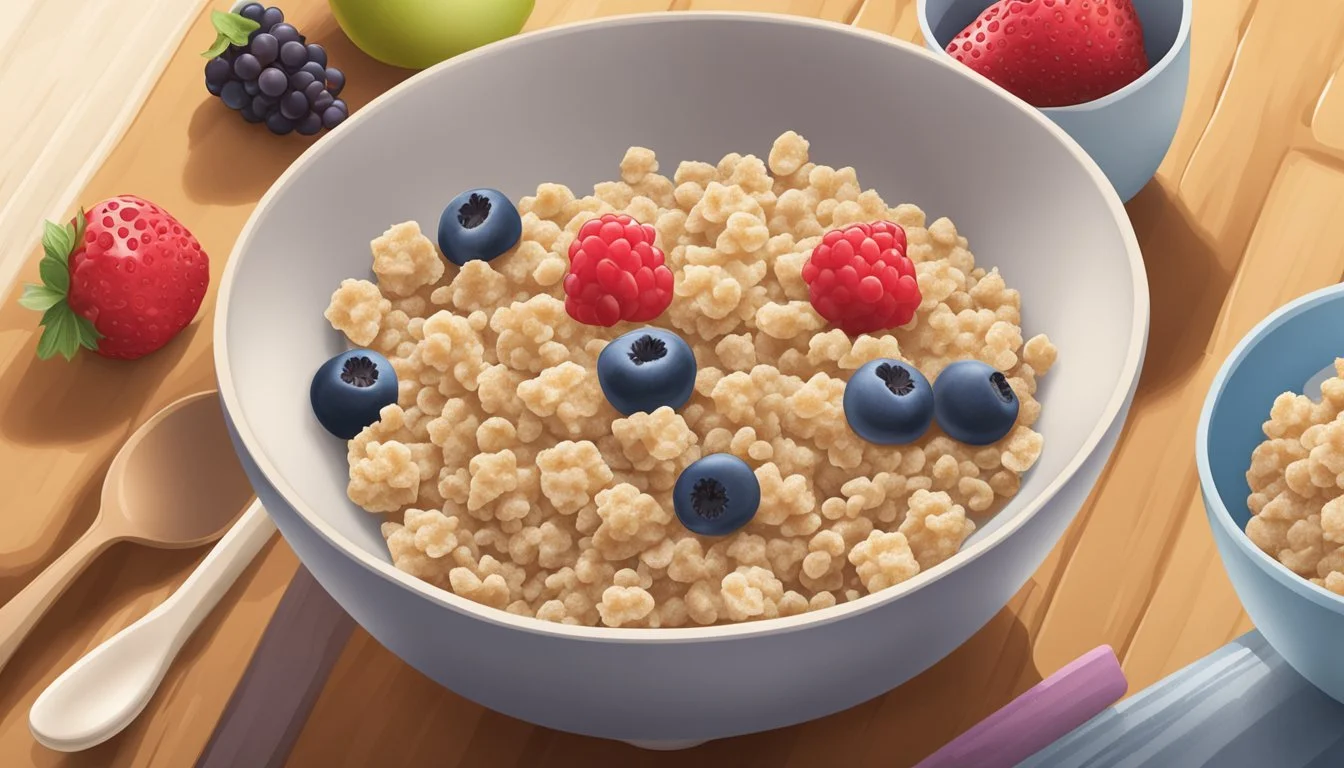All-Bran vs Rice Krispies
Nutritional Face-off and Health Benefits Comparison
This Article is Part of Our Breakfast Cereal Guide with Details on All-Bran Nutrition and Rice Krispies Nutrition
Choosing the right breakfast cereal can make a significant difference in your daily nutrition. When comparing All-Bran and Kellogg's Rice Krispies, it's clear that each offers distinct benefits and drawbacks. All-Bran stands out with a higher fiber content, making it a better option for digestive health and maintaining regularity.
All-Bran contains 7.0 grams of complex carbohydrates per serving, emphasizing its role as a fiber-rich cereal that can aid in long-term satiety. In contrast, Kellogg's Rice Krispies, with 22.0 grams of complex carbohydrates per serving, leans more toward a quick energy boost. This makes Rice Krispies popular among those who prefer a lighter, crispier texture and faster energy release.
Nutritionally, it's important to note that All-Bran also provides a substantial amount of essential vitamins and minerals, while Rice Krispies has a simpler ingredient list typically comprising rice and sugar. For anyone prioritizing nutrient density and digestive health in their breakfast routine, All-Bran may be the more effective choice.
Cereal Nutrition Fundamentals
The nutritional profile of a cereal can significantly impact overall health. Key elements such as caloric content, protein, fiber, sugar, fat, and cholesterol offer a comprehensive view of a cereal's benefits and drawbacks.
Caloric Content Evaluation
When comparing cereals, calories per serving is a primary aspect. All-Bran provides 80 calories per serving, which is relatively low. On the other hand, Rice Krispies offer 130 calories per serving.
Consumers should consider their daily caloric needs when selecting cereals. Those looking to maintain or reduce their caloric intake might find All-Bran more suitable. Rice Krispies, although higher in calories, still fall within a reasonable range for a balanced diet.
Protein and Fiber Analysis
Protein and fiber content are crucial for their roles in maintaining muscle mass and digestive health. All-Bran contains 4g of protein and an impressive 10g of fiber per serving. This makes it a robust choice for those needing high fiber intake.
In contrast, Rice Krispies contain only 2g of protein and less than 1g of fiber per serving. The minimal fiber content indicates Rice Krispies are less beneficial for digestive health compared to All-Bran.
Sugar Content Assessment
Sugar content is a major concern when evaluating breakfast cereals. All-Bran has 6g of sugar per serving, which is relatively moderate. Rice Krispies have 4g of sugar per serving.
Even though Rice Krispies contain slightly less sugar, the difference is minor. For consumers looking to minimize sugar intake, All-Bran and Rice Krispies are fairly comparable in their sugar content.
Fat and Cholesterol Comparison
Evaluating fat and cholesterol can determine the suitability of a cereal for heart health. All-Bran contains 0.5g of saturated fat and 0mg of cholesterol per serving, which positions it as a heart-healthy option.
Rice Krispies, with 0g of fat and cholesterol, also rank well in this category. Both cereals present minimal risks associated with saturated fat and cholesterol, making them good choices for individuals monitoring their heart health.
By analyzing calorie content, protein and fiber levels, sugar content, and fat and cholesterol, consumers can make informed choices about which cereal aligns best with their nutritional goals.
Health Benefits and Downsides
All-Bran and Rice Krispies differ significantly in their nutrient profiles and potential health impacts. Each cereal offers unique benefits and drawbacks concerning cardiovascular health, digestive health, blood sugar levels, and weight management.
Cardiovascular Health Factors
All-Bran is rich in dietary fiber, which can aid in lowering cholesterol levels, contributing to improved heart health. It contains less sodium compared to many other cereals, making it a heart-friendlier option. Moreover, its whole-grain content provides essential nutrients and minerals that support cardiovascular health.
Rice Krispies, on the other hand, are lower in fiber and higher in refined carbohydrates. They lack whole grains and their associated heart-healthy benefits. While they are free of harmful oils, their low fiber content does little to aid heart health.
Digestive Health Contributions
All-Bran is well-known for its high fiber content, particularly insoluble fiber, which is crucial for maintaining regular bowel movements and preventing constipation. The fiber aids in feeding beneficial gut bacteria, promoting a healthy digestive system.
Rice Krispies have a much lower fiber content, making them less effective for digestive health. They can be considered a more processed cereal with fewer benefits for maintaining good digestive function. Thus, they might not be the best choice for individuals focusing on fiber intake and digestive health.
Effects on Blood Sugar Levels
All-Bran has a lower glycemic index due to its high fiber content, which helps regulate blood sugar levels. The slower digestion of complex carbohydrates in All-Bran results in a gradual release of glucose into the bloodstream, making it a better option for individuals managing blood sugar levels.
Rice Krispies consist primarily of refined rice and simple carbohydrates, leading to a higher glycemic index. This can cause rapid spikes and drops in blood sugar levels, which is less desirable for those monitoring their blood sugar. The lower fiber and higher sugar content complicate this cereal's role in maintaining stable blood glucose.
Weight Management Potential
All-Bran may aid weight management through its high fiber content, which promotes satiety and helps control hunger. The nutrients and minerals in All-Bran also provide essential components for a balanced diet, supporting weight loss efforts in a healthy manner.
Rice Krispies offer fewer benefits for weight management due to their lower fiber and higher simple carb content, which may lead to quicker hunger and more frequent snacking. The lower nutrient density makes it less suitable for a weight loss diet. While low in fat, they do not provide the same satiety level as high-fiber cereals like All-Bran.
Ingredients and Additives
When comparing All-Bran and Rice Krispies, it’s crucial to examine their ingredients and additives, which can affect their nutritional value. The key components include vitamins and minerals enrichments, the presence of whole grains and bran, and added sugars and artificial colors.
Vitamins and Minerals Enrichment
All-Bran and Rice Krispies both benefit from added vitamins and minerals.
All-Bran often has added B vitamins such as B6, B12, niacin, and folic acid. It may also include minerals like iron and zinc, important for various body functions.
Rice Krispies similarly contain added vitamins and minerals. Commonly, these include vitamins B1, B2, B6, B12, and D, along with iron. Fortification helps enhance the nutritional profile beyond what the base ingredients offer.
Presence of Whole Grains and Bran
Whole grains and bran significantly impact fiber content.
All-Bran is made primarily from wheat bran, which provides a high amount of fiber, particularly insoluble fiber. This aids in digestive health and regularity.
Rice Krispies, on the other hand, are made from puffed rice and generally lack whole grains. Therefore, they contain minimal fiber and do not offer the same benefits as whole grain cereals like All-Bran or bran flakes.
Added Sugars and Artificial Colors
The level of added sugars and artificial colors can greatly affect the overall healthiness of a cereal.
All-Bran tends to have lower added sugar content compared to many other cereals. It also typically avoids the use of artificial colors, making it a more plain and straightforward option.
Rice Krispies, while often perceived as a simple cereal, contains higher added sugar levels. Though it generally avoids artificial colors, the added sugars contribute to its higher carbohydrate count per serving. This makes it less ideal for those monitoring their sugar intake.
Serving Suggestions and Varieties
Selecting the right serving sizes and enhancing your cereal with a variety of toppings can significantly improve its nutritional value and taste. Additionally, understanding the different formulations available for each cereal can help customize your breakfast experience.
Recommended Serving Sizes
For All-Bran, a typical serving size is around 1/2 cup (about 40 grams). This amount provides a rich source of fiber.
Rice Krispies, on the other hand, usually has a serving size of 1 1/4 cups (about 33 grams). It's lighter in weight but offers a different nutritional profile.
Check the packaging for precise serving measurements since serving sizes can alter nutritional intake. These sizes are designed to balance nutritional benefits with caloric intake.
Toppings and Mix-In Ideas
Enhancing cereals with a variety of toppings can boost their nutritional value:
Nuts: Almonds, walnuts, or pecans add protein and healthy fats.
Fresh Fruit: Bananas, berries, and apple slices introduce vitamins and natural sweetness.
Dried Fruit: Raisins, cranberries, or apricots offer concentrated sources of nutrients and fiber.
Seeds: Chia, flax, or sunflower seeds can add essential omega-3 fatty acids and a crunchy texture.
Granola or Muesli: These add an extra layer of complexity and nutrients.
Combining these toppings with either All-Bran or Rice Krispies can create a balanced and nutritious meal.
Different Cereal Formulations
Different formulations cater to varying dietary preferences and needs:
All-Bran offers variants like All-Bran Original, All-Bran Buds, and All-Bran Flakes. Each variety has a distinct texture and fiber content.
Rice Krispies can be found in classic, gluten-free, and even flavored versions. The choice depends on dietary restrictions and taste preferences.
Reading labels carefully can help identify the most suitable option. Formulations may also include fortified vitamins and minerals, ensuring a well-rounded diet.
Using these different types, one can customize their cereal experience to match nutritional needs and flavor preferences.
Consumer Demographics and Preferences
When comparing All-Bran and Rice Krispies, understanding consumer preferences is key.
Children often gravitate towards Rice Krispies due to its taste and the engaging snap, crackle, and pop sounds. The cereal's lower fiber content and higher sugar may appeal to younger palates.
All-Bran, touted as a healthier breakfast option, appeals more to adults seeking higher fiber and higher protein in their diets. Many adults prefer it for its health benefits, particularly those prioritizing lower sugar intake.
A cross-section of health-conscious consumers tends to choose All-Bran for its nutritional benefits, making it a staple among those focused on maintaining a balanced diet.
Preferences among breakfast cereal consumers often vary with their lifestyle choices. Those looking for a quick, tasty option might lean towards Rice Krispies, while those committed to a healthy breakfast might opt for All-Bran.
Here's a brief comparison in tabular format:
Criteria Rice Krispies All-Bran Primary Consumers Children, Teens Adults Fiber Low High Protein Moderate High Sugar Higher Lower Health Appeal Taste, Experience Nutritional Value
Parents often make cereal choices based on nutritional content for their children, balancing between taste satisfaction and health benefits.
Regulatory Aspects and Standards
Understanding the regulatory aspects and standards surrounding cereals like All-Bran and Rice Krispies is crucial. This section looks into nutritional labeling guidelines and food additive regulations.
Nutritional Labeling Guidelines
Cereal brands must follow strict nutritional labeling guidelines as per Food and Drug Administration (FDA) regulations. Labels must display serving size, calories, and nutrient information, including the grams of complex carbohydrates, protein, fat, dietary fiber, and sugars per serving.
For All-Bran, a typical serving includes 7.0 grams of complex carbohydrates. In contrast, Rice Krispies has 22.0 grams. Labels must also list micronutrients like vitamins and minerals, ensuring consumers are informed about their nutritional choices. Both cereals also need to indicate milligrams of sodium per serving, contributing to daily intake limits.
Food Additive Regulations
Food additives in cereals like BHT (butylated hydroxytoluene) and artificial colors are strictly regulated to ensure safety. All additives must be FDA-approved and listed on the product packaging.
Manufacturers must provide clear information on the presence of any artificial colors or preservatives like BHT. This helps consumers with allergies or sensitivities to certain ingredients to make informed decisions. Detailed additive information also pertains to any fortifications, such as the inclusion of micronutrients to enhance the cereal's nutritional value.
Conclusion
Choosing between All-Bran and Kellogg's Rice Krispies for breakfast involves considering several factors.
All-Bran offers a higher fiber content, providing 7.5 grams per serving. This makes it a preferred choice for those looking to improve digestive health and maintain a high-fiber diet. The presence of complex carbohydrates can also help sustain energy levels throughout the morning.
Kellogg's Rice Krispies, on the other hand, contain 22 grams of complex carbohydrates per serving. While they are lower in fiber compared to All-Bran, Rice Krispies are known for being light and easy to digest, making them a suitable option for a quick breakfast or a snack.
When it comes to other nutritional aspects, All-Bran tends to have a lower sugar content, which can be beneficial for those managing their sugar intake. The differences in nutrient profiles highlight the importance of aligning food choices with personal health goals.
Balancing taste preferences and nutritional needs is crucial. Those prioritizing a healthy lifestyle may lean towards All-Bran, whereas others seeking a lighter cereal might prefer Rice Krispies.
Ultimately, the decision depends on individual dietary requirements and health objectives. Both cereals can fit into a balanced diet, contributing to varied and nutritious food choices.









